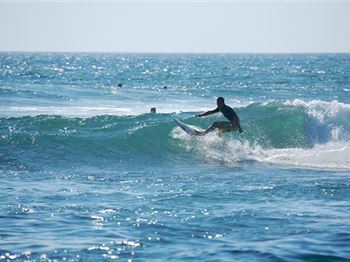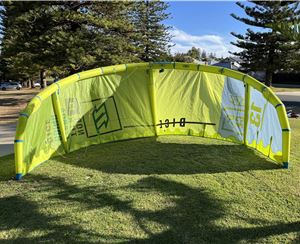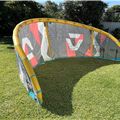Kitesurfing Terminology & Lingo
* air time: the amount of time spent in the air while jumping. Five to ten seconds is not unusual.
* apparent wind: the kite's speed relative to the surrounding air. When kitesurfing in a straight line, the kite's apparent wind is a combination of the wind speed and the speed of the kite and rider over the surface, but since the kite is highly steerable apparent wind can vary widely depending on how the kite is being flown. Most ways of increasing power from the kite involve giving it a higher apparent wind somehow, i.e. diving the kite, riding faster, or riding at a greater angle into the wind. Any of these raises the kite's apparent wind speed.
* body dragging: being pulled through the water without standing on a board. This is an early step in the learning process, and is recommended before trying the board after flying a trainer kite.
* boost: to send the kite such that the rider becomes airborne
* chicken loop: a hard rubber loop attached to the middle line which has been fed through the control bar. It is used to attach the control bar to the harness so the kitesurfer can produce tension in the lines using their entire bodyweight instead of using purely arm strength.
* chicken bone/chicken finger: a hard rubber "tongue" attached to the chicken loop which the rider feeds through the spreader bar hook to prevent the rider from becoming "unhooked".
* de-power: to reduce the kite's power (pull), generally by adjusting the angle of attack of the kite. Most kites and control bars now allow a rider to rig a kite for a number of different power levels before launching, in addition to powering the kite up and down "on the fly" by moving the bar up and down. Depowerability makes a kite safer and easier to handle. Some new kite models, especially "bow" kites, can be de-powered to practically zero power, giving them an huge wind range.
* DP: Dawn patrol; a very early morning session.
* donkey dick: same as "chicken bone".
* downwind: the direction the wind is blowing towards; to leeward. When a rider is facing downwind the wind is at their back.
* downwinder: a great day out where the kiter goes on a long journey downwind, and generally needs a mate or the bus to get back where they started. Although some may be as short as 5km's, some have travelled hundreds.
* edge: tilting the board with its edge into the water. Used to control the direction of travel. Learning to edge properly is critical for learning to tack upwind. Edging is one of the fundamental skills of kitesurfing and is one of the ways kitesurfing is different from windsurfing or wakeboarding. While windsurf boards have daggerboards and/or skegs to steer the board upwind while lift and planing is provided by the board itself, generally kiteboards actually combine both functions and the bottom of the board lifts the rider and steers simultaneously. Kiteboard fins are generally much smaller and are for keeping the board in the water (see "tea-bagging"), but are not essential. Because kite boards have a small rocker, a deep edge can allow the board to act as a large low drag fin. Edging in wakeboarding is used for steering the board; whereas in kite boarding not only does edging steer the kite board, it is essential for kite control and controlling board speed. Riding downwind towards the kite subtracts massively from the kite's power and helps control board speed as well.
* heel side: the side of a board on the edge where a riders heels are (opposite of toeside). "Riding heelside" is riding with heels down. Heelside is the normal and most comfortable riding position.
* Hindenburg: A reference to the Hindenburg Airship disaster of 1937, which in kitesurfing terminology refers to the kite stalling and falling out of the sky. Hindenburging can be caused either by lack of wind or by the kite advancing to a position upwind of the kitesurfer in the wind window.
* handlepass: while unhooked, passing the control bar behind a riders back while in the air
* kiteloop: one of the most "powered up" moves in kitesurfing where the rider loops the kite downwind whilst already airborne. The power surge is intense and is akin to being yanked by a truck. Requires great courage and smelling salts to perform.
* kitemare: a kiteboardsurfing accident or dangerous mishap. Kitemares can be deadly.
* lofted: to get lifted vertically into the air by the kite by a strong gust of wind. A very dangerous occurrence that has resulted in several fatalities when kiters on or near land have been dragged into obstacles. Can be avoided my minimizing time on land with the kite flying directly overhead, not kiting in overpowered situations, and being incredibly warey during winter storms.
* luff : when the air flow stalls around the kite. It may then stall and fall out of the sky. Like sails, a luffing kite has rippling and flapping panels. When launching the kite, if the kite is luffing, the rider should move farther upwind, or the person holding the kite should move downwind.
* mobe: This term has two meanings. It can either be used to describe a class of wakestyle tricks: any invert with a 360 degree spin is considered a "mobe." Also, this term can denote a specific trick: a back roll with a frontside 360 handlepass (while keeping the kite below 45 degrees); this specific trick is also known as "the mobe." The term "mobe" (as a class of tricks) is historically rooted in the fact that the mobe (the specific trick) was the first type of mobe to ever be landed. Other types of mobes include: mobe 540, mobe 720, slim chance, KGB, crow mobe, moby dick, Pete Rose, blind pete, crow mobe 540, etc.
* nuking: wind blowing at great speeds(30-40 knots). These conditions are the very extreme of most wind speeds riders will encounter. Thus they can be dangerous and/or exciting depending on the rider.
* offshore: wind blowing at the water from the shore. Never ride in offshore winds without some means of recovery, i.e. a chase boat. This is somewhat less important in smaller bodies of water, of course.
* onshore: wind blowing perpendicular to and directly at the shore from the water. A challenging condition for beginners, especially if waves are present. Presents a dangerous condition if doing tricks too close to shore, or launching in dodgy winds.
* overhead waves: waves two or more meters (6 ft) from trough to crest;
* overpowered: the condition of having too much power from the kite. Can be a result of an increase in wind, incorrect kite choice (too large for the conditions), incorrect adjustment or simply going too fast.
* power up: when the kite's power increases because of wind gusts or the kite's movement.
* power zone: is the area in the sky where the kite generates the most pull, this is generally between 0 to 60 degrees arc from the center of the downwind direction.
* send it: To move the kite aggressively up through the power zone.
* schlogging: This is riding extremely underpowered. A rider has no power to plane and definitely not enough to jump. A rider and their board bounce from planing on the surface to being dragged in the water.
* side shore, winds blowing parallel to the shore. Usually the most desirable direction for kitesurfing.
* side onshore: wind blowing between sideshore and at a 45 degree angle towards the shore.
* spreader bar: A stainless steel bar that attaches to the rider's harness. It has a hook that holds the "chicken loop" when riding hooked in.
* tack: The direction which is being sailed, normally either starboard tack or port tack. In a starboard tack the wind is coming in from the rider's starboard (right-hand) side, similar to sailing a boat. In normal riding, the kitesurfer takes a heading which is as close to into the wind as possible, and in any event leads at some angle slightly upwind, sometimes as much as 45 degrees; jumping or wave riding usually results in traveling downwind, so the net result is to maintain relative position. Alternately, see "downwinder".
* tea-bagging: popping out of and falling back into the water intermittently due to light or gusty wind, poor flying skills, twisted lines.
* teabagger: used as a term of friendship and endearment by participants of alternative sports. ;-)
* toe side: the side of a board on the edge where a riders toes are (opposite of heel side). "Riding toe side" is riding with toes down.
* underpowered: the condition of having insufficient power from the kite. Can be a result of insufficient wind, choosing a kite that is too small for the current wind, rigging incorrectly, board too small, water current in the same direction as the wind, not riding fast enough, etc. A rider who is continuously diving the kite and sending it back up in a sine-wave pattern is usually underpowered.
* unhooked: when a kitesurfer is riding while the chicken loop is not attached to the rider's harness.
* upwind: the direction from which the wind is blowing; windward; into the wind.
* wind window: the 120-180 degree arc of the sky downwind of the rider in which the kite can be flown. Roughly one fourth of a sphere's surface. If the rider is facing downwind on a flat surface, like the ocean, the wind window consists of roughly all the area the rider can see, from the rider's peripheral vision on one side, along the horizon to the other side, and then directly overhead back to the first side. If the rider somehow puts the kite out of the window -- for example, by riding downwind very quickly and sending the kite directly overhead and behind -- the kite will stall and frequently fall out of the sky.
* zenith: location in the wind window directly over the kiter's head. This is the neutral position where kitesurfers can place the kite to stop moving or prior to movement.
![]()

Safer Kitesurfing from a pilots perspective
How a fighter pilot approaches a mission is how a kitesurfer can approach a sick kite session













